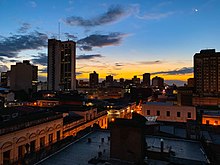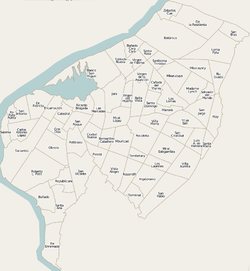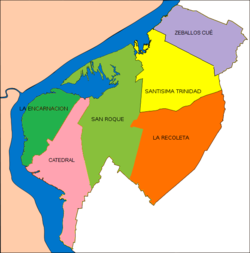Asunción
![]()
This article is about the city of Asunción in Paraguay, for other meanings see Asunción (disambiguation).
![]()
This article or subsequent section is not sufficiently supported by evidence (e.g., anecdotal evidence). Information without sufficient evidence may be removed in the near future. Please help Wikipedia by researching the information and adding good supporting evidence.
Asunción [asunˈθi̯ɔn, Latin asunˈsi̯ɔn] is the capital and with about 525,000 inhabitants (as of 2016), also the largest city of the state of Paraguay in South America. Its name (Spanish for Assumption, Ascension) stands for Assumption of the Virgin Mary, and its full name is La Muy Noble y Leal Ciudad de Nuestra Señora Santa Maria de la Asunción. The metropolitan area of Asunción has about 1.9 million inhabitants. Its name in the national language Guaraní is Paraguay (not to be confused with Paraguái, the country name in Guaraní).

Asunción in the evening
Geography
Asunción is located on the left bank of the Río Paraguay, on the bay (bahía) Asunción. It borders Mariano Roque Alonso to the northeast, Luque to the east, Fernando de la Mora to the southeast, and Lambaré and Villa Elisa to the south.
The highest elevation is the Cerro Lambaré in the district of Santa Ana in the border area to the neighboring city of Lambaré. The Cerro Lambaré was awarded to Asunción in 1965. Lambaré tried to have the old border restored in 2008-2009, but failed due to the resistance of the Senate.
Other elevations are hills (lomas or colinas). These are fully integrated into the urban layout. The most important - seven in number, located in the city center - are called:
- Loma Cabará: here one assumes the founding place of Asunción
- Loma San Gerónimo
- Loma Clavel: today's headquarters of the Marines
- Loma Cachinga
- Loma del Mangrullo: the present Parque Carlos Antonio López
- Loma de la Encarnación
- Loma de las piedras de Santa Catalina: today Escalinata Antequera.
Today, the Lomas Tarumá and Tacumbú, the seat of the penitentiary, are also included.
Asunción is crossed by many small streams that flow into the Paraguay River. Most of these streams rise in the urban area of Asunción and served in earlier centuries for the drinking water supply. Nowadays, most of them are blocked. During heavy rains they can turn into torrents and flood adjacent streets and properties. The most important of these streams are called Mburicaó, Cará Cará, Jaén, Mburicá, Salamanca, Zanja Morotí, San Vicente and Leandro. Discharged water partly accumulates in lagoons close to the river. As these are practically "stagnant waters", they pose a relevant health risk.
breeding sites of the Aedes aegypti mosquitoes
The standing waters are breeding grounds for the dengue-transmitting mosquitoes Aedes Aegypti. The situation is aggravated by the lack of a rainwater drainage system and the customary illegal disposal of waste on uninhabited land. Due to the relatively high population density, this led to a dengue epidemic in January 2007 with over 10,000 people falling ill in Asunción alone. A state of emergency was declared. The country's worst dengue epidemic broke out in 2013, with over 150,000 infected and 262 deaths, mainly affecting the capital.
Infection rates can vary greatly from one neighbourhood (barrio) to another, depending on local conditions. The neighbourhoods with the highest infection rates in January 2018 were Ycuá Satí 12.5%, Manorá 11%, Ricardo Brugada 10.7%, Bella Vista 10%, Zeballos Cué 9%, Tucumbú 9%, San Blas 7.8%, Herrera 7.8%, Loma Pytá 6.5%, Mburucuyá 6%, Obrero 3.9%.
Climate
| Asunción | ||||||||||||||||||||||||||||||||||||||||||||||||
| Climate diagram | ||||||||||||||||||||||||||||||||||||||||||||||||
| ||||||||||||||||||||||||||||||||||||||||||||||||
| Monthly average temperatures and precipitation for Asunción
Source: WMO 1971-2000; wetterkontor.de | ||||||||||||||||||||||||||||||||||||||||||||||||||||||||||||||||||||||||||||||||||||||||||||||||||||||||||||||||||||||||||||||||||||||||||||||||||||||||||||||||||||||||||||||||||||||||||||||||||||||||||||||||||||||||||||||||||||||||||||||||||||||||||||

Panorama of Asunción
City breakdown
Overview / Special feature
Asunción is divided into districts (distritos) and neighborhoods (barrios). The division by distritos dates from the mid-19th century and is based on the division of the city into Catholic dioceses. The division by distritos therefore only includes today's inner city and does not extend to newer barrios.
Asunción is a city that grows from the inside out. Every year, new neighborhoods are created that now completely fill the areas between the city proper of Asunción and the surrounding towns of Mariano Roque Alonso, Luque, Fernando de la Mora, Ñemby and Lambaré (also known collectively as "Gran Asuncíón"). Often the barrios are built on the basis of "urbanizaciones", residential areas developed by real estate agents in as yet unnamed neighborhoods. In newer barrios, the name of the urbanización and the actual name of the barrio coincide. In many cases, the name of the urbanización is more common in the vernacular than the official name of the barrio.
Distritos (Districts)
- La Encarnación
- Catedral
- San Roque
- Recoleta
- Trinidad
- Zeballos Cué
Barrios (districts)
Asunción currently has 70 barrios. The most populated barrios are Roberto L. Petit, San Pablo and Obrero. (as of 2002)
|
|
|
|
|

Barrios of Asunción

Distritos of Asunción
Search within the encyclopedia